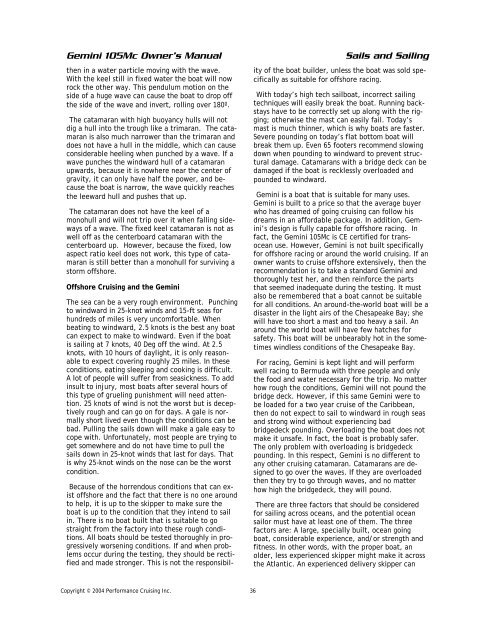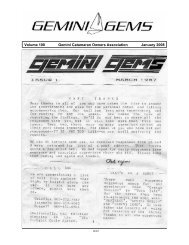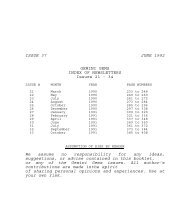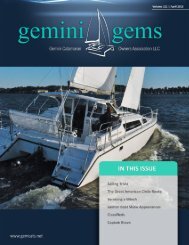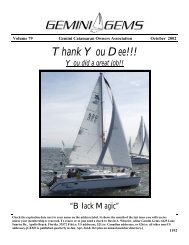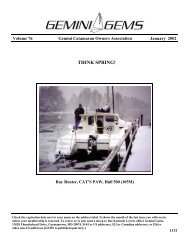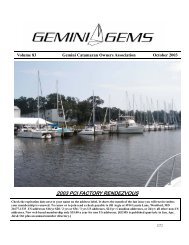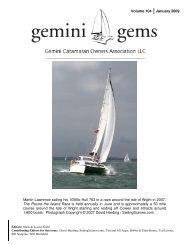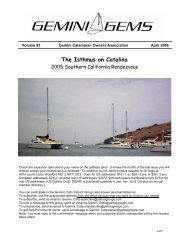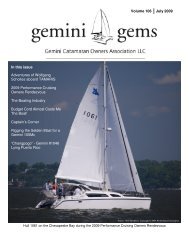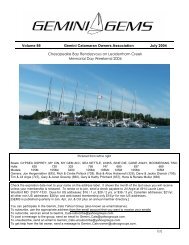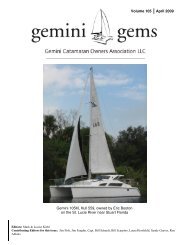Gemini Owners Manual.pub - Gemini Gems
Gemini Owners Manual.pub - Gemini Gems
Gemini Owners Manual.pub - Gemini Gems
You also want an ePaper? Increase the reach of your titles
YUMPU automatically turns print PDFs into web optimized ePapers that Google loves.
<strong>Gemini</strong> 105Mc Owner’s <strong>Manual</strong><br />
then in a water particle moving with the wave.<br />
With the keel still in fixed water the boat will now<br />
rock the other way. This pendulum motion on the<br />
side of a huge wave can cause the boat to drop off<br />
the side of the wave and invert, rolling over 180º.<br />
The catamaran with high buoyancy hulls will not<br />
dig a hull into the trough like a trimaran. The catamaran<br />
is also much narrower than the trimaran and<br />
does not have a hull in the middle, which can cause<br />
considerable heeling when punched by a wave. If a<br />
wave punches the windward hull of a catamaran<br />
upwards, because it is nowhere near the center of<br />
gravity, it can only have half the power, and because<br />
the boat is narrow, the wave quickly reaches<br />
the leeward hull and pushes that up.<br />
The catamaran does not have the keel of a<br />
monohull and will not trip over it when falling sideways<br />
of a wave. The fixed keel catamaran is not as<br />
well off as the centerboard catamaran with the<br />
centerboard up. However, because the fixed, low<br />
aspect ratio keel does not work, this type of catamaran<br />
is still better than a monohull for surviving a<br />
storm offshore.<br />
Offshore Cruising and the <strong>Gemini</strong><br />
The sea can be a very rough environment. Punching<br />
to windward in 25-knot winds and 15-ft seas for<br />
hundreds of miles is very uncomfortable. When<br />
beating to windward, 2.5 knots is the best any boat<br />
can expect to make to windward. Even if the boat<br />
is sailing at 7 knots, 40 Deg off the wind. At 2.5<br />
knots, with 10 hours of daylight, it is only reasonable<br />
to expect covering roughly 25 miles. In these<br />
conditions, eating sleeping and cooking is difficult.<br />
A lot of people will suffer from seasickness. To add<br />
insult to injury, most boats after several hours of<br />
this type of grueling punishment will need attention.<br />
25 knots of wind is not the worst but is deceptively<br />
rough and can go on for days. A gale is normally<br />
short lived even though the conditions can be<br />
bad. Pulling the sails down will make a gale easy to<br />
cope with. Unfortunately, most people are trying to<br />
get somewhere and do not have time to pull the<br />
sails down in 25-knot winds that last for days. That<br />
is why 25-knot winds on the nose can be the worst<br />
condition.<br />
Sails and Sailing<br />
Because of the horrendous conditions that can exist<br />
offshore and the fact that there is no one around<br />
to help, it is up to the skipper to make sure the<br />
boat is up to the condition that they intend to sail<br />
in. There is no boat built that is suitable to go<br />
straight from the factory into these rough conditions.<br />
All boats should be tested thoroughly in progressively<br />
worsening conditions. If and when problems<br />
occur during the testing, they should be rectified<br />
and made stronger. This is not the responsibility<br />
of the boat builder, unless the boat was sold specifically<br />
as suitable for offshore racing.<br />
With today’s high tech sailboat, incorrect sailing<br />
techniques will easily break the boat. Running backstays<br />
have to be correctly set up along with the rigging;<br />
otherwise the mast can easily fail. Today’s<br />
mast is much thinner, which is why boats are faster.<br />
Severe pounding on today’s flat bottom boat will<br />
break them up. Even 65 footers recommend slowing<br />
down when pounding to windward to prevent structural<br />
damage. Catamarans with a bridge deck can be<br />
damaged if the boat is recklessly overloaded and<br />
pounded to windward.<br />
<strong>Gemini</strong> is a boat that is suitable for many uses.<br />
<strong>Gemini</strong> is built to a price so that the average buyer<br />
who has dreamed of going cruising can follow his<br />
dreams in an affordable package. In addition, <strong>Gemini</strong>’s<br />
design is fully capable for offshore racing. In<br />
fact, the <strong>Gemini</strong> 105Mc is CE certified for transocean<br />
use. However, <strong>Gemini</strong> is not built specifically<br />
for offshore racing or around the world cruising. If an<br />
owner wants to cruise offshore extensively, then the<br />
recommendation is to take a standard <strong>Gemini</strong> and<br />
thoroughly test her, and then reinforce the parts<br />
that seemed inadequate during the testing. It must<br />
also be remembered that a boat cannot be suitable<br />
for all conditions. An around-the-world boat will be a<br />
disaster in the light airs of the Chesapeake Bay; she<br />
will have too short a mast and too heavy a sail. An<br />
around the world boat will have few hatches for<br />
safety. This boat will be unbearably hot in the sometimes<br />
windless conditions of the Chesapeake Bay.<br />
For racing, <strong>Gemini</strong> is kept light and will perform<br />
well racing to Bermuda with three people and only<br />
the food and water necessary for the trip. No matter<br />
how rough the conditions, <strong>Gemini</strong> will not pound the<br />
bridge deck. However, if this same <strong>Gemini</strong> were to<br />
be loaded for a two year cruise of the Caribbean,<br />
then do not expect to sail to windward in rough seas<br />
and strong wind without experiencing bad<br />
bridgedeck pounding. Overloading the boat does not<br />
make it unsafe. In fact, the boat is probably safer.<br />
The only problem with overloading is bridgedeck<br />
pounding. In this respect, <strong>Gemini</strong> is no different to<br />
any other cruising catamaran. Catamarans are designed<br />
to go over the waves. If they are overloaded<br />
then they try to go through waves, and no matter<br />
how high the bridgedeck, they will pound.<br />
There are three factors that should be considered<br />
for sailing across oceans, and the potential ocean<br />
sailor must have at least one of them. The three<br />
factors are: A large, specially built, ocean going<br />
boat, considerable experience, and/or strength and<br />
fitness. In other words, with the proper boat, an<br />
older, less experienced skipper might make it across<br />
the Atlantic. An experienced delivery skipper can<br />
Copyright © 2004 Performance Cruising Inc.<br />
36


